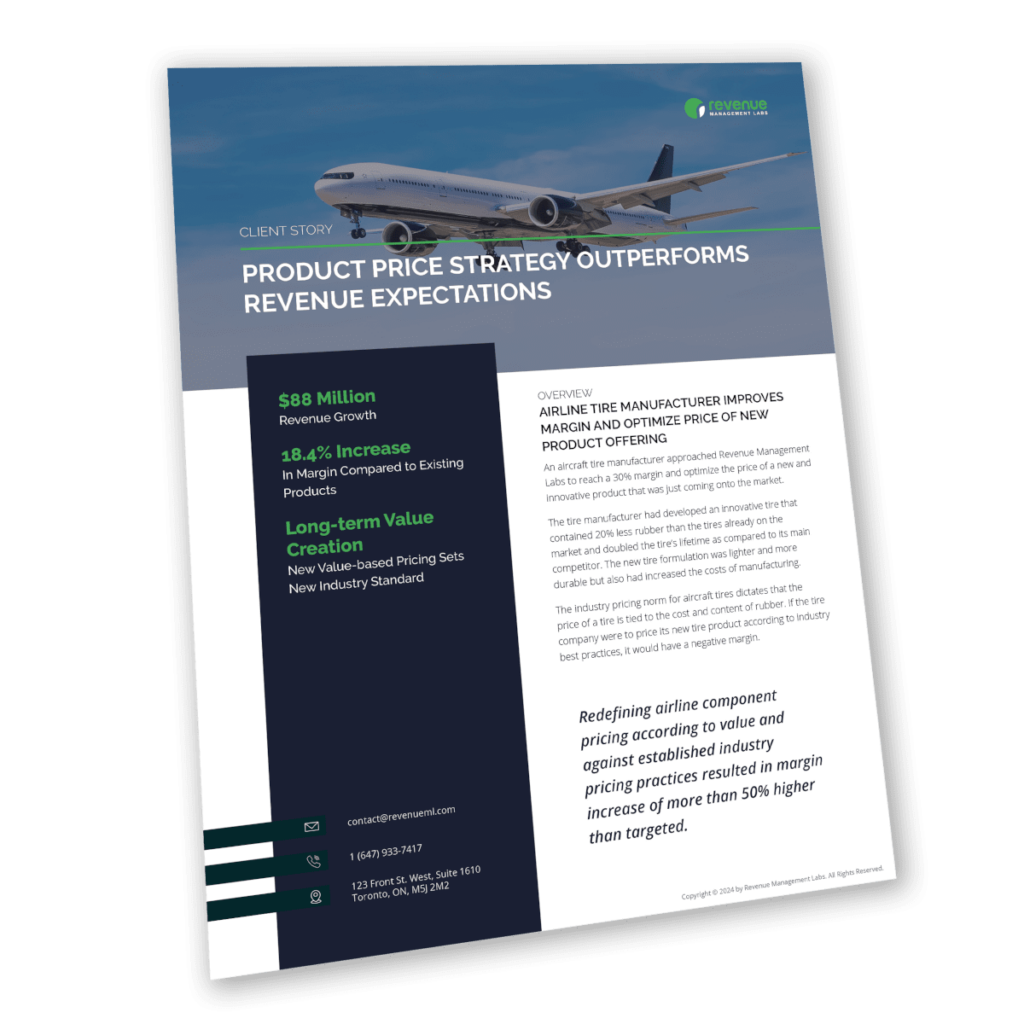Redefining airline component pricing according to value and against established industry pricing practices resulted in margin increase of more than 50% higher than targeted.
An aircraft tire manufacturer approached Revenue Management Labs to reach a 30% margin and optimize the price of a new and innovative product that was just coming onto the market.
The tire manufacturer had developed an innovative tire that contained 20% less rubber than the tires already on the market and doubled the tire’s lifetime as compared to its main competitor. The new tire formulation was lighter and more durable but also had increased the costs of manufacturing.
The industry pricing norm for aircraft tires dictates that the price of a tire is tied to the cost and content of rubber. If the tire company were to price its new tire product according to industry best practices, it would have a negative margin.
The airline tire company had set a target of 30% margin on the new tire product but would not be able to reach this goal with the current pricing strategies in place. The company had historically used either a margin-based pricing or a market-based pricing both of which proved problematic for differing reasons.
The margin-based pricing strategy would reach the needed 30% target but when viewed against competitor offerings, it comes in at a significantly higher price point and without justification.
The market-based pricing strategy refers to pricing tires according to the cost and content of rubber, as described in the overview. The price point is more competitive but would result in a negative margin due to the higher manufacturing costs.
Revenue Growth
In Margin Compared to Existing Products
New Value-based Pricing Sets New Industry Standard

The new pricing strategy had two components, the price and the selling story. The price was based on a customer analysis that identified the financial value of a higher price point than competitor tires, while accounting for other adjustment factors related to size, certainty, speed. The new value-based, list-price was more than double the main competitor’s.
The second component to the pricing strategy, the selling story, was developed in collaboration with the sales team to effectively communicate the financial value of the innovation and overcome any skepticism related to the potential savings.
To shift from a cost-based and market-based pricing strategy, Revenue Management Labs focused their analysis on the airline tire company’s customer base to identify their value drivers. From that analysis, they discovered that the main financial value of the tire would come from reducing maintenance and fuel costs. The tire’s durability meant that it could double the lifetime of its main competitor and potentially save customers $1,570. An additional $666 in fuel savings came from the tire’s lighter weight for a total of $2,236 in savings.
Outside of price, the revenue consultants at Revenue Management Labs identified five other factors that would impact the final price and included: competitor discounting, operating cost requirements, cost of capital, payback period, and selling story.
After accounting for all price and non-price related factors, the company landed on a list price of $2,471 as compared to the competitor’s $1,270.
For a detailed review of the pricing tools, download the full case study on value-based pricing for the airline industry.
The strength of the pricing strategy came from its foundation in quantifying the value of the new product offering and then developing a strong selling story that resonated with the pain points of customers. The customer analysis identified value drivers and then Revenue Management Labs linked the product to the customer’s need to save on operational costs.
The result far exceeded expectations. Instead of a 30% margin improvement, the tire company reached 48.4% margin, a 18.4% margin increase as compared to existing products, and $80 million in revenue growth.
We are here to help you achieve profitable revenue growth
Phone: +1 (647) 933-7417
Inquiries: contact@revenueml.com

We will cover the full results from our 2024 Executive Pricing Survey. See how you compare to your competitors both in past performance and for 2024 pricing strategy.